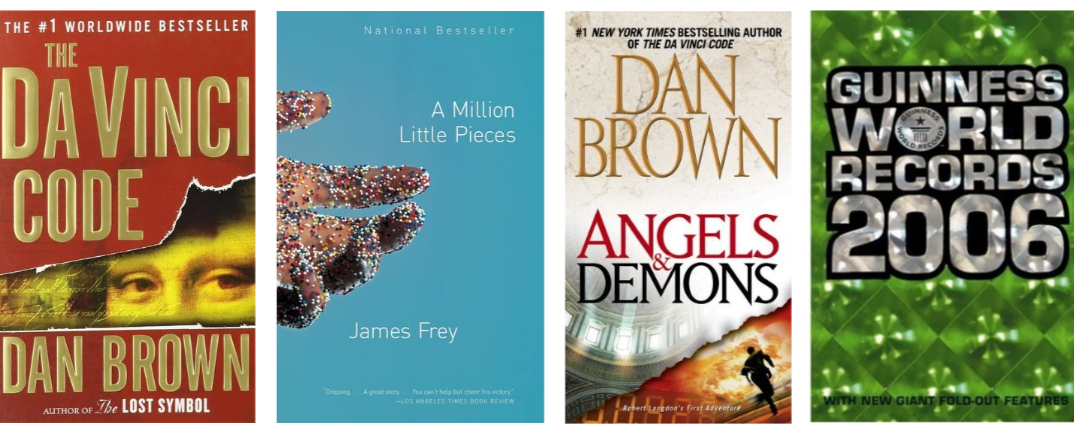The wait is over. Our long anticipated study on book-to-screen adaptations is here!
Must-Watch, Must-Read: Book-to-Screen Adaptations in the Canadian Book Market 2022 features data from 30 book-to-TV and 60 book-to-film adaptations from 2020 and 2021 and their impact on the Canadian book market.
In it, you’ll find insights that go beyond what we’ve already shared in our blog series, including how Canadian book sales and library circulation are influenced by:
COVID-19 pandemic restrictions on bookstores, libraries, and movie theatres;
an adapted title’s publication date, subject, or inclusion in a book series;
the adaptation’s audience rating, release type, or release date; and
key dates in an adaptation’s development timeline.
You can download this study for free in two accessible digital formats. Get your PDF or EPUB copy now!
To celebrate the study’s release, we’re bringing you a final piece of data about book adaptations that didn’t make it into the final study — Media Tie-ins.
What about Media Tie-ins?
There are 10 Media Tie-In categories in BISAC related to Media Tie-in titles, spanning Fiction, Non-Fiction, Young Adult, and Juvenile subjects.
Media Tie-in subjects are meant for titles that are related to and promote another type of media — a film, TV show, video game, website, or something else entirely.
More often than not, a title that’s been adapted into a film or TV show will have a Media Tie-in edition. We’ve all seen them — they’re the ones with an image from the film as the book cover or a badge telling you it’s been adapted into a hit TV show.
Based on our past research into book adaptations and Media tie-in titles, we know that Media tie-in titles are usually published three or more weeks in advance of an adaptation’s release. And these titles support the promotion of the adaptation just as much as they do the source material.
But Media Tie-ins aren’t only for books adapted into TV shows or films. The reverse — an existing TV show or film turned book — also falls into this category.
So, how do Media Tie-in titles fit in? We take a look at the sales and library circulation of Media Tie-in categories, using our SalesData and LibraryData services to find out.
Buying Media Tie-in
While it feels like there are more book adaptations than ever, the popularity of Media Tie-in titles for Canadian book buyers seems to be waning in recent years.
The graph below shows the sales of all Media Tie-in subjects from 2017 to 2021. Between 2017 and 2021, sales for these titles have consistently decreased 33%, with the overall marketshare for Media Tie-in titles also down 34%. From 2020 to 2021, this was only a 2% reduction in volume sold and a 1% reduction in marketshare.
Sales of Media Tie-in titles from 2017 to 2021
Out of all 10 Media Tie-in BISAC subjects, the top selling categories in 2021 were:
Juvenile / Juvenile Fiction / Media Tie-In — 71% of all Media Tie-in sales;
Fiction / Media Tie-In — 7% of all Media Tie-in sales; and
Juvenile Fiction / Comics & Graphic Novels / Media Tie-In — 5% of all Media Tie-in sales.
Borrowing Media Tie-in
On the other hand, Media Tie-ins seem to be more popular in Canadian libraries.
With LibraryData launching in fourth quarter of 2019, the graph below represents library circulation data for 2020 and 2021. Here, the number of library loans and library renewals of Media Tie-in titles are up from 2020 and 2021, increasing 47% and 58% respectively.
Taking into account shifting pandemic restrictions that limited Canadians' access to libraries in 2020, these increases don’t necessarily mean that there’s more demand for Media Tie-in titles. Looking more closely, the loan and renewal shares for these titles in the library actually decreased in 2021 — down 1% for both loans and renewals.
There’s also another important factor to consider here — the data itself. SalesData and LibraryData store ISBNs differently. While SalesData gathers data for each individual ISBN, LibraryData uses ISBN clusters. These ISBN clusters may contain any number of ISBNs related to one title or to a series of books. As a result, multiple editions of the same title find themselves in a cluster together — editions that may have different BISAC codes. When we pull Trend Analysis reports by subject in LibraryData, each cluster is associated with one BISAC subject — the one from its most recent edition.
What does this mean for Media Tie-In titles? For a title that’s been adapted into TV show or film, Media Tie-In is only used as a BISAC code for a specific edition of the title, instead of its regular subject code. For a time, LibraryData would consider its cluster as belonging to the Media Tie-In subject, as the Media Tie-In title would be the most recently published one. But once another edition of an adapted title is published that isn’t categorized as Media Tie-In, the cluster will no longer be associated with the Media Tie-In subject. It follows that the majority of clusters considered to be Media Tie-In have titles that are published relatively recently. This fluctuation may also account for the higher number of loans and renewals of Media Tie-In titles in 2021 — there may just more clusters considered as Media Tie-Ins.
Library circulation of Media Tie-in titles from 2020 to 2021
Of the 10 Media Tie-in BISAC subjects, the top borrowed categories in 2021 were:
Juvenile / Juvenile Fiction / Media Tie-In — 59% of all Media Tie-in loans and 59% of all Media Tie-in renewals;
Non-Fiction / Comics & Graphic Novels / Media Tie-In — 12% of all Media Tie-in loans and 13% of all Media Tie-in renewals; and
Juvenile Fiction / Comics & Graphic Novels / Media Tie-In — 11% of all Media Tie-in loans and 12% of all Media Tie-in renewals.
Reading Media Tie-in Titles
Taking everything into consideration, Media Tie-in titles in demand by Canadian readers. Here are the top selling and top borrowed Media Tie-in titles from 2021.
Top borrowed
Oishisou!! The Ultimate Anime Dessert Cookbook by Hadley Sui, illus. by Monique Narboneta Zosa
The Walking Dead: The Fall of the Governor Part Two by Robert Kirkman and Jay Bonansinga
Franklin Rides a Bike by Paulette Bourgeois 🍁 , illus. by Brenda Clark 🍁
Baby Shark: Little Fish Lost by Pinkfong
Encanto: Family is Everything by Luz M. Mack, illus. by The Disney Storybook Art Team
Top selling
Pokémon: Super Extra Deluxe Essential Handbook by Scholastic
The One and Only Ivan by Katherine Applegate, illus. by Patricia Castelao
The Hate U Give by Angie Thomas
The Hating Game by Sally Thorne
Paw Patrol: Seven Ruff-Ruff Rescues! by Random House

















Top Canadian Jr. picks for January 2026.